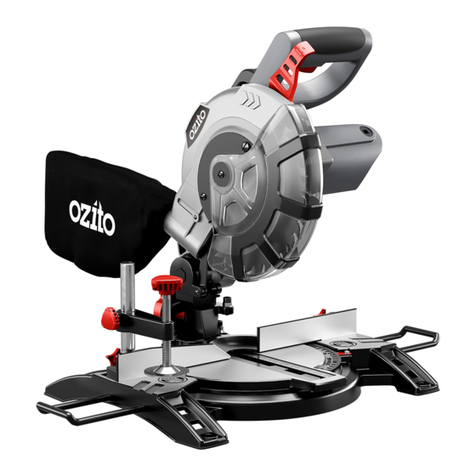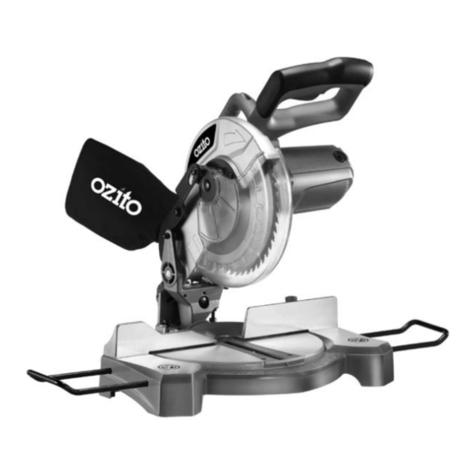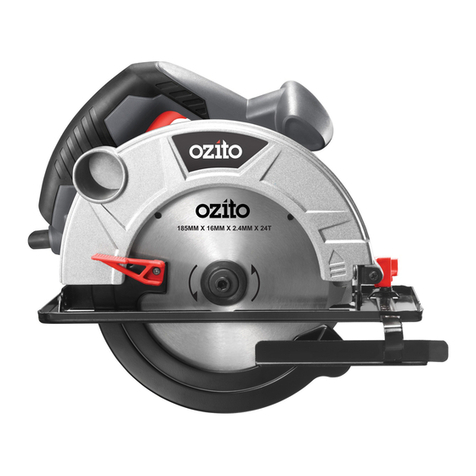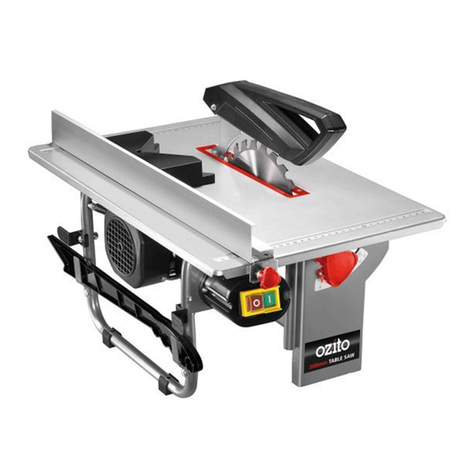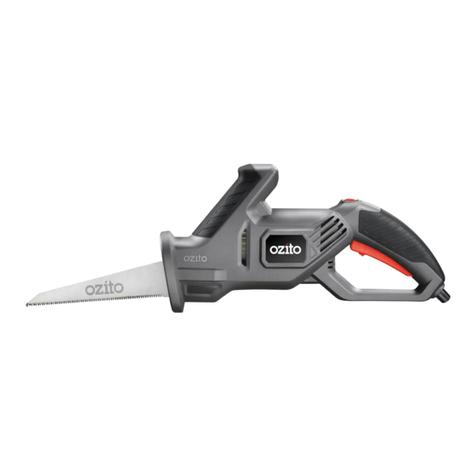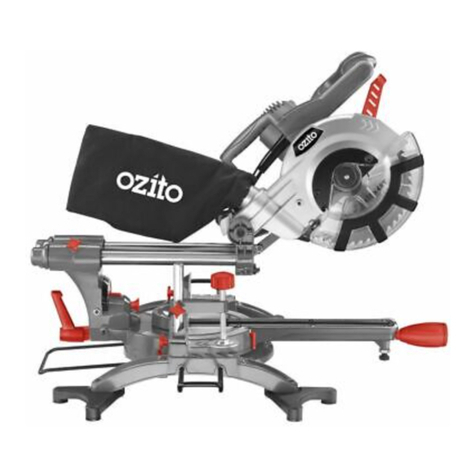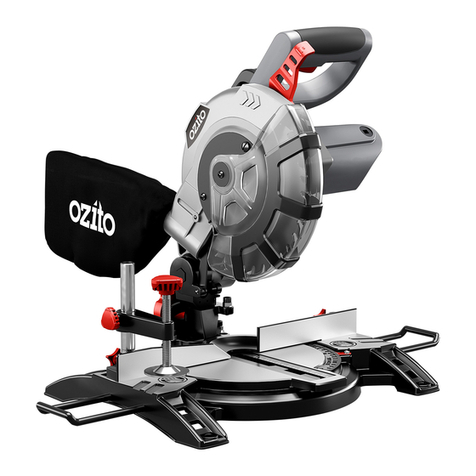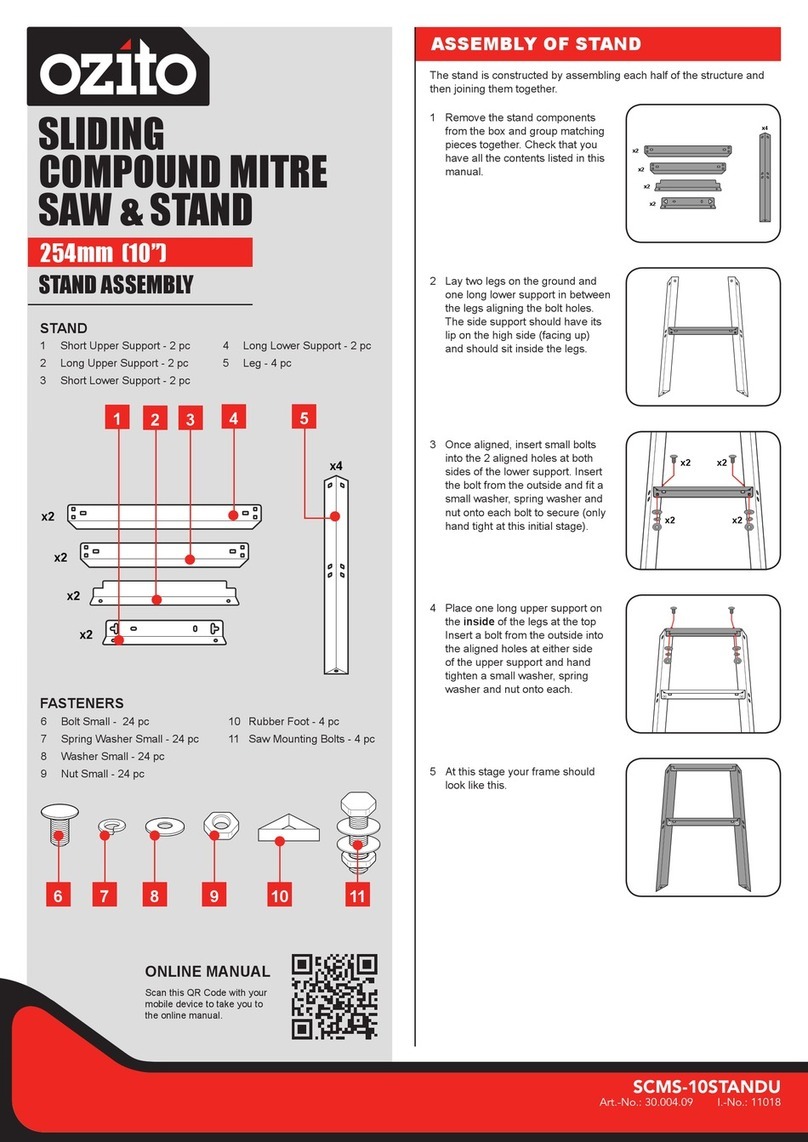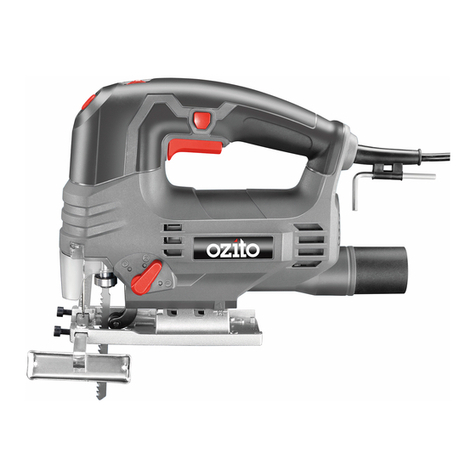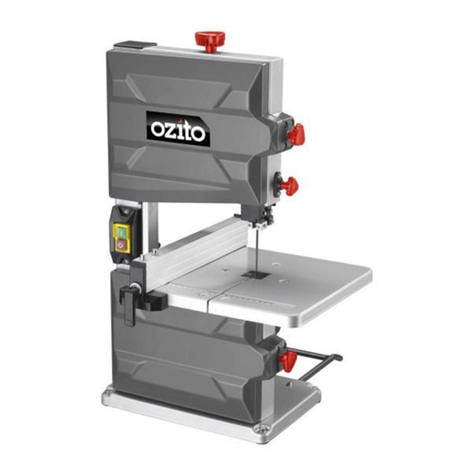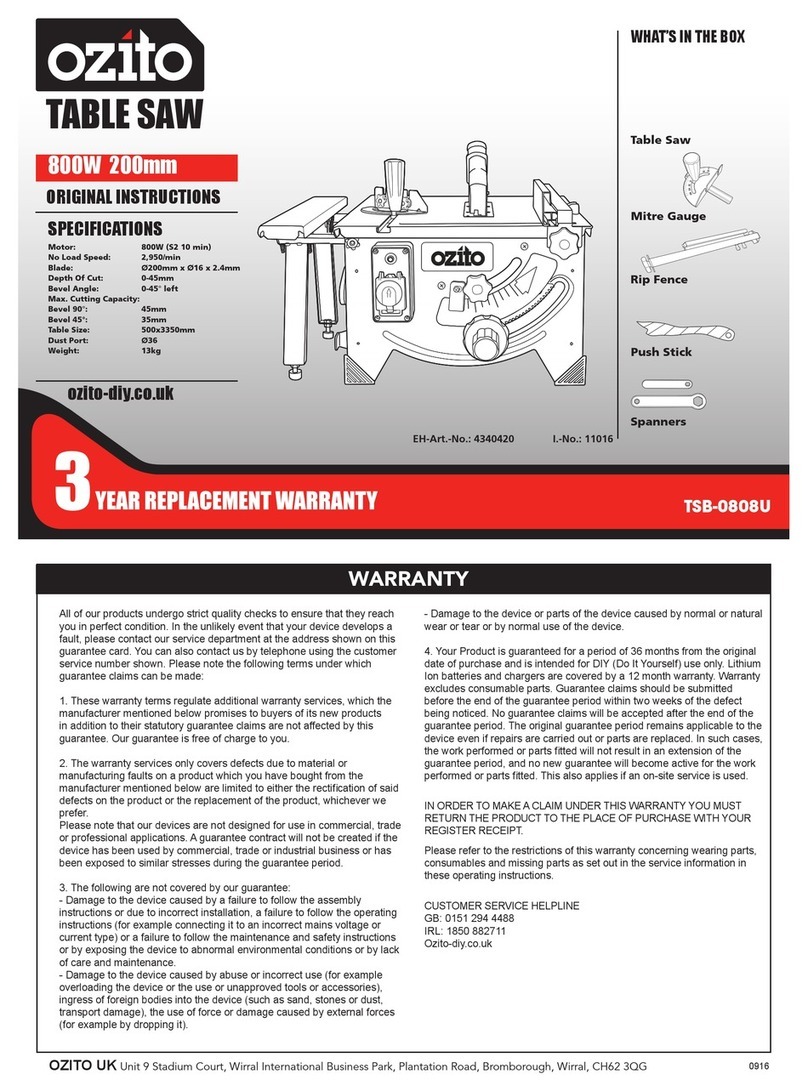
This appliance is not intended for use by young or inrm persons unless supervised by a
responsible person to ensure that they can use the appliance safely. Young children should
be supervised to ensure that they do not play with the appliance.
WARNING! Before connecting a tool to a power source (mains switch power point
receptacle, outlet, etc.) be sure that the voltage supply is the same as that specied on
the nameplate of the tool. A power source with a voltage greater than that specied for the
tool can result in serious injury to the user,as well as damage to the tool. If in doubt, do not plug in
the tool.
Using a power source with a voltage less than the nameplate rating is harmful to the motor.
a) This tool is designed to cut timber products only.
Do not use the tool to cut any other materials.
b) Do not cut rewood with this tool. The irregular shape of rewood makes it unsafe to cut
with this tool.
c) Prior to operating, connect a dust extractor to the tool. This will ensure a dust- free
environment for safer operation.
d) Always use recommended size blade. Do not use smaller or larger blades.
e) Do not use dull or damaged blades. Unsharpened or improperly set blades produce narrow
*kerf causing excessive friction, blade binding and kickback.
f) Never use damaged or incorrect blade washers or blade bolts. The blade bolt and
washers are specically designed for the tool for optimum performance and safety of operation.
g) Ensure the blade is properly tted and rotates in the correct direction.
Incorrectly tted blades can cause damage to the material and tool and injury to the operator.
h) Do not use damaged blades. This can result in serious injury to the operator and damage to
the tool.
i) Do not use abrasive or dado blades. This can result in serious injury to the operator and
damage to the tool.
j) When the blade binds in material being cut, switch o the tool and wait for blade to
come to a complete stop. Investigate and take corrective action to eliminate cause of binding.
k) Blade depth and bevel adjusting locking levers must be tight and secure before making
a cut. If blade adjustment shifts while cutting, it may cause binding and kickback.
l) Do not use the tool without guards in place and operating correctly. Failure to adhere to
this may cause damage to the material and tool and injury to the operator.
m) Ensure all clamps, levers and locking knobs are securely tightened prior to operation.
This will result in projects being produced accurately and safely.
n) Support large panels to minimise risk of blade pinching and kickback. Large panels
tend to sag under their own weight. The use of roller stands and/or extension tables is
recommended.
o) Allow motor to reach full speed prior to inserting blade into timber. This will result in safe
operation and clean cuts.
p) Never place any part of your body in the blade area while the power is connected. Injury
will be prevented by the accidental starting of the tool.
q) Never attempt to stop the blade by wedging an object against the blade. This can result in
serious injury to the operator and damage to the tool.
r) Extremely small pieces of timber should not be cut with this tool in either mode. This can
result in serious injury to the operator caused by ying debris.
s) Recommendation for the use of a residual current device with a rated residual current
device of 30mA or less.
t) When ripping, always use the rip fence. This improves the accuracy of cut and reduces the
chance of the blade binding.
u) Always use the push stick, especially when cutting narrow pieces of timber. Do not place
hands in the near vicinity of the blade while operating the tool.
v) Ensure that the riving knife is properly positioned prior to operating. This will prevent the
timber from binding up and stalling the blade.
w) Do not over reach to retrieve material from behind the blade. This can result in serious
injury to the operator.
x) Do not use the saw to perform rebate or groove cuts unless suitable guarding, such as
tunnel guard, is tted above the saw table.
y) Do not use the saw for slotting (stopped groove) cuts.
z) Use only transportation devices and never use the cuttings guards for handling or
transportation when transporting the machine.
aa) Always ensure the blades are covered by the blade guard during transportation.
bb) Always store the push stick together with the table saw when not in use.
*kerf - groove cut in timber
TABLE SAW SAFETY WARNINGS
IMPORTANT! RISK OF INJURY!
NEVER REACH INTO THE RUNNING SAW BLADE.
WARNING! When using mains-powered stationary appliances, basic safety precautions,
including the following, should always be followed to reduce risk of re, electric shock,
personal injury and material damage.
Read the whole manual carefully and make sure you know how to switch the tool o in an emergency, before
operating the tool.
Save these instructions and other documents supplied with this tool for future reference.
The electric motor has been designed for 230V and 240V only. Always check that the power supply
corresponds to the voltage on the rating plate.
Note: The supply of 230V and 240V on Ozito tools are interchangeable for Australia and New Zealand.
This tool is double insulated therefore no earth wire is required.
If the supply cord of this power tool is damaged, it must be replaced by a specially prepared cord available
through the service organization.
Note: Double insulation does not take the place of normal safety precautions when operating this tool. The
insulation system is for added protection against injury resulting from a possible electrical insulation failure
within the tool.
Using an Extension Lead
Always use an approved extension lead suitable for the power input of this tool. Before use, inspect the
extension lead for signs of damage, wear and ageing. Replace the extension lead if damaged or defective.
When using an extension lead on a reel, always unwind the lead completely. Use of an extension lead not
suitable for the power input of the tool or which is damaged or defective may result in a risk of re and electric
shock.
GENERAL POWER TOOL SAFETY WARNINGS - PERSONAL SAFETY
ELECTRICAL SAFETY
WARNING! Read all safety warnings and all instructions. Failure to follow the warnings and
instructions may result in electric shock, re and/or serious injury.
Save all warnings and instructions for future reference. The term “power tool” in the
warnings refers to your mains-operated (corded) power tool or battery-operated (cordless) power
tool.
1. Work area safety
a. Keep work area clean and well lit. Cluttered or dark areas invite accidents.
b. Do not operate power tools in explosive atmospheres, such as in the presence of ammable
liquids, gases or dust. Power tools create sparks
which may ignite the dust or fumes.
c. Keep children and bystanders away while operating a power tool. Distractions can cause you to
lose control.
2. Electrical safety
a. Power tool plugs must match the outlet. Never modify the plug in any way.
Do not use any adapter plugs with earthed (grounded) power tools. Unmodied plugs and matching
outlets will reduce risk of electric shock.
b. Avoid body contact with earthed or grounded surfaces, such as pipes, radiators, ranges and
refrigerators. There is an increased risk of electric shock
if your body is earthed or grounded.
c. Do not expose power tools to rain or wet conditions. Water entering a power tool will increase the
risk of electric shock.
d. Do not abuse the cord. Never use the cord for carrying, pulling or unplugging the power tool.
Keep cord away from heat, oil, sharp edges or moving parts. Damaged or entangled cords increase
the risk of electric shock.
e. When operating a power tool outdoors, use an extension cord suitable
for outdoor use. Use of a cord suitable for outdoor use reduces the risk of electric shock.
3. Personal safety
a. Stay alert, watch what you are doing and use common sense when operating a power tool. Do
not use a power tool while you are tired or under the inuence of drugs, alcohol or medication. A
moment of inattention while operating power tools may result in serious personal injury.
b. Use personal protective equipment. Always wear eye protection. Protective equipment such as dust
mask, non-skid safety shoes, hard hat, or hearing protection used for appropriate conditions will reduce
personal injuries.
c. Prevent unintentional starting. Ensure the switch is in the o-position before connecting to
power source and/or battery pack, picking up or carrying the tool. Carrying power tools with your
nger on the switch or energising power tools that have the switch on invites accidents.
d. Remove any adjusting key or wrench before turning the power tool on.
A wrench or a key left attached to a rotating part of the power tool may result
in personal injury.
e. Do not overreach. Keep proper footing and balance at all times. This enables better control of the
power tool in unexpected situations.
f. Dress properly. Do not wear loose clothing or jewellery. Keep your hair, clothing and gloves away
from moving parts. Loose clothes, jewellery or long hair can be caught in moving parts.
g. If devices are provided for the connection of dust extraction and collection facilities, ensure
these are connected and properly used. Use of dust collection can reduce dust-related hazards.
h. Do not let familiarity gained from frequent use of tools allow you to become complacent and
ignore tool safety principles. A careless action can cause severe injury within a fraction of a second.
4. Power tool use and care
a. Do not force the power tool. Use the correct power tool for your application. The correct power tool
will do the job better and safer at the rate for which it was designed.
b. Do not use the power tool if the switch does not turn it on and o. Any power tool that cannot be
controlled with the switch is dangerous and must be repaired.
c. Disconnect the plug from the power source and/or the battery pack from the power tool before
making any adjustments, changing accessories, or storing power tools. Such preventive safety
measures reduce the risk of starting the power tool accidentally.
d. Store idle power tools out of the reach of children and do not allow persons unfamiliar with the
power tool or these instructions to operate the power tool. Power tools are dangerous in the hands
of untrained users.
e. Maintain power tools. Check for misalignment or binding of moving parts, breakage of parts and
any other condition that may aect the power tool’s operation. If damaged, have the power tool
repaired before use. Many accidents are caused by poorly maintained power tools.
f. Keep cutting tools sharp and clean. Properly maintained cutting tools with sharp cutting edges are
less likely to bind and are easier to control.
g. Use the power tool, accessories and tool bits etc. in accordance with these instructions, taking
into account the working conditions and the work to be performed. Use of the power tool for
operations dierent from those intended could result in a hazardous situation.
h. Keep handles and grasping surfaces dry, clean and free from oil and grease. Slippery handles and
grasping surfaces do not allow for safe handling and control of the tool in unexpected situations.
5. Service
a. Have your power tool serviced by a qualied repair person using only identical replacement
parts. This will ensure that the safety of the power tool
is maintained.
